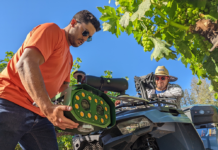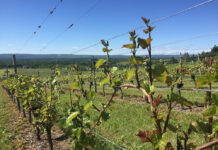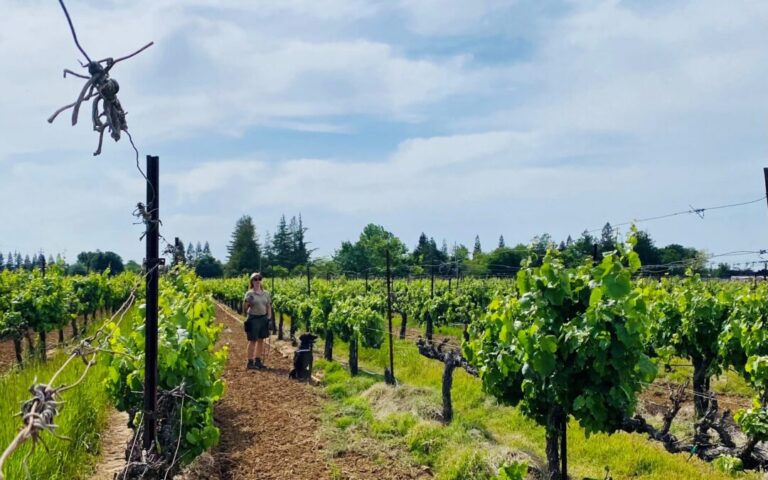
Specially trained dogs have been used to sniff out bombs, drugs and earthquake survivors, and now they’re proving their worth in finding grape pests.
A proof-of-concept trial led by the Lodi Winegrape Commission found trained dogs could identify vines with vine mealybug (VMB) infestations or grapevine leafroll-associated virus 3 (GLRaV-3) infections with at least 90% accuracy. It was funded by a $428,000 California Department of Pesticide Regulation grant.
Having a cost-effective and non-destructive way to accurately identify infected vines fits nicely into the commission’s areawide integrated pest management and sustainability efforts, said Stephanie Bolton, commission grower research and education director.
Preventing GLRaV-3-infected vines from being planted in a vineyard should be at the forefront, she said. If vines become infected in a vineyard, the sooner they can be identified and removed, the less chance there is of GLRaV-3 spreading to neighboring vines or vineyards. Several growers within the Lodi area have ongoing programs to survey vineyards for GLRaV-3 in the fall when symptoms in red varieties are most prominent, send samples for laboratory confirmation and remove infected vines in the winter. The challenge is with white varieties, which exhibit few if any outward symptoms, making visual disease detection nearly impossible.
GLRaV-3 is only part of the equation. The Lodi effort also includes reducing populations of VMB, which transmit the virus. With input from the industry and researchers, the commission developed an integrated VMB pest management program that includes using clean plant material, surveying and pest detection, judicious use of insecticides, ant control and mating disruption.
An added cause for the concern is recent research suggests GLRaV-3 and one or more grapevine vitiviruses together may contribute to sudden vine collapse. Symptoms start with stunted vine growth, and within a matter of weeks, entire vines die and become dried out. The issue appears to be associated with sensitive rootstocks, including Freedom.
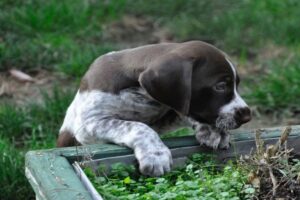
Early Detection
Bolton said she got the idea for the project after hearing Tim Gottwald, a now-retired USDA-ARS plant pathologist, talk about using dogs to sniff out the causal agent of citrus greening. Also known as huanglongbing or HLB, the bacterial disease has decimated the Florida citrus industry. It is spread by Asian citrus psyllid.
California agricultural pest management leaders hope to slow the spread of HLB and Asian citrus psyllid within the state to prevent an outcome like Florida’s.
In his trials, Gottwald found trained dogs could identify infected trees with more than 99% accuracy. They also could find trees within two weeks of inoculating with Candidatus Liberibacter asiaticus, which causes HLB. That compared to laboratory PCR testing, which identified only 3% of infections at two months after inoculation. In trials, the dogs had a 100% detection rate for Asian citrus psyllid.
Bolton, who was the principal investigator on the grant, turned to Lisa Finke, owner of Canine Detection Services in Fresno. Finke had already trained dogs and shown the value of using their super-developed olfactory senses to detect bedbugs, Asian citrus psyllid and HLB. She currently is training several dogs to detect ACP and HLB in Ventura County as part of a CDFA survey program.
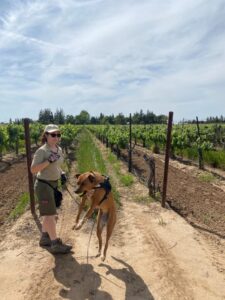
Although Finke said most dogs can be trained to detect pests if they have the drive, she prefers mid-sized, floppy-eared breeds, such as Labrador retrievers and springer spaniels, for field work. They’re tall enough to reach branches or cordons without having to stand on their hind legs all the time yet their floppy ears project a welcoming animal.
The Lodi project was the first time Finke had worked with a virus pest, but she used the same training techniques she had with the bacterial disease HLB, citrus psyllid and bedbugs.
“It took me a year because these are tricky target odors,” Finke said about GLRaV-3. With that experience under her belt, she said she could now train a dog to detect the grape virus in one to six months.
As part of the grant, Finke acquired and trained nine dogs. In both indoor and outdoor trials, she and Bolton used potted grapevines on which they attached small pieces of VMB-infested or virus-infected plant material. They also included VMB mating disruption as well as several winegrape varieties to try to intentionally distract the dogs.
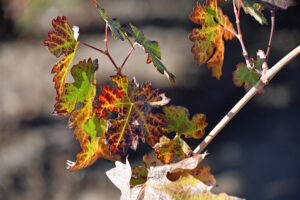
The proof-of-concept project culminated with field trials in real vineyards. To avoid moving VMB, Bolton had the dogs conduct insect-detection trials in the commission’s demonstration vineyard, which was already infested. The GLRaV-3 field trial was conducted in a vineyard in which every vine had been laboratory tested for the virus. Using plots of 25 vines, they conducted 17 to 18 reps.
Among all three detection set-ups for VMB, the dogs averaged 97.3% sensitivity and 99.6% specificity. A high specificity means few false positives.
For GLRaV-3, the dogs averaged 93.4% sensitivity and 99.6% specificity among all three types of tests. That compared to the results from five labs, which averaged 92.9% sensitivity and 91.4% specificity.
“These results kind of blew away the results from the lab,” Bolton said. “The dogs and the handlers only improved with time. The vine mealybug dogs were even better. By the time they got to the end of the trials, they were 100%.”
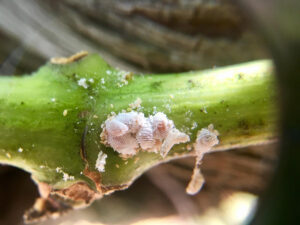
Most Bang for the Buck
Where Bolton sees detection dogs providing the most value is in nurseries, based on the concentrated number of vines for which they’re responsible. One mother vine, for example, may provide budwood for propagating 20 or 30 scions.
Although the state Grapevine Registration & Certification Program samples nurseries, it tests less than 1% of vines in registered increase blocks for viruses and only does so once every five years.
“Rootstocks and white grape varieties, whether at the FPS nursery level or the grower commercial vineyard level, can be sneaky sources of virus inoculum,” Bolton said. “There is a lot of false sense of security around the grape certification program. There’s a dire need for something better.”
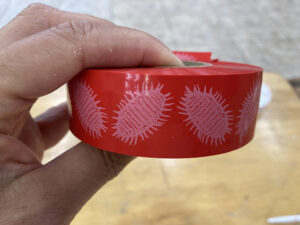
Bolton was referring to the lack of visual GLRaV-3 symptoms in infected rootstocks or white grape varieties. Infected red grape varieties typically exhibit reddish leaves with green veins in the fall. But that’s not true in all cases.
If detection dogs continue performing as they have, Bolton said they could help significantly reduce the number of infected asymptomatic vines moving from nurseries into vineyards. That would go a long way to addressing GLRaV-3, she said.
Based on an economic analysis of their research project, Bolton said detection dogs could inspect nurseries at a cost of about 1 cent per vine.



